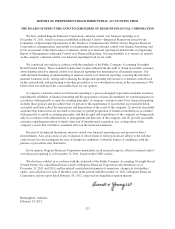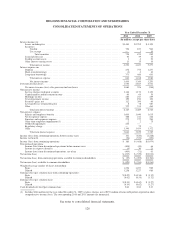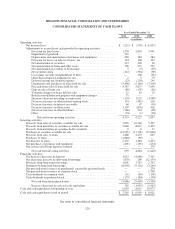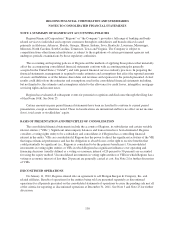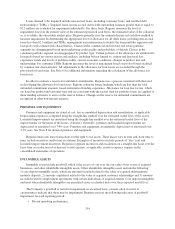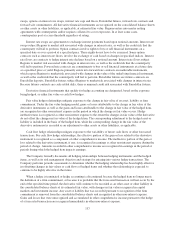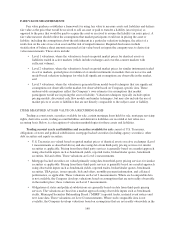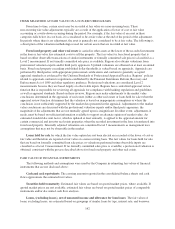Regions Bank 2011 Annual Report Download - page 157
Download and view the complete annual report
Please find page 157 of the 2011 Regions Bank annual report below. You can navigate through the pages in the report by either clicking on the pages listed below, or by using the keyword search tool below to find specific information within the annual report.is reasonably quantifiable. Factors considered in making these determinations are the borrower’s and any
guarantor’s ability and willingness to pay, the status of the account in bankruptcy court (if applicable), and
collateral value. Commercial and investor real estate loan relationships of $250,000 or less are subject to
charge-off or charge down to estimated value less costs to sell at 180 days past due, based on collateral value.
Non-accrual and charge-off decisions for consumer loans are dictated by the Federal Financial Institutions
Examination Council’s (FFEIC) Uniform Retail Credit Classification and Account Management Policy which
establishes standards for the classification and treatment of consumer loans. Non-accrual status is driven by the
charge-off process as follows. If a consumer loan secured by real estate in a first lien position (residential first
mortgage or home equity) becomes 180 days past due, Regions evaluates the loan for non-accrual status and
potential charge-off based on net loan to value exposure. For home equity loans in a second lien position, the
analysis is performed at 120 days past due. If a loan is secured by collateral having a realizable value sufficient to
fully discharge the obligation, then a partial write-down is not necessary and the loan remains on accrual status,
provided it is in the process of legal collection. If a partial charge-off is necessary as a result of the evaluation,
then the remaining balance is placed on non-accrual. Consumer loans not secured by real estate are either 1)
charged-off in full at 120 days past due for closed-end loans, 180 days past due for open-end loans other than
credit cards or the end of the month in which the loan becomes 180 days past due for credit cards, or 2) partially
written down to estimated collateral value less estimated costs to sell no later than 120 days past due for home
equity second liens or at 180 days past due for residential and home equity first liens.
When a commercial or investor real estate loan is placed on non-accrual status, uncollected interest accrued
in the current year is reversed and charged to interest income. Uncollected interest accrued from prior years on
commercial and investor real estate loans placed on non-accrual status in the current year is charged against the
allowance for loan losses. When a consumer loan is placed on non-accrual status, all uncollected interest accrued
is reversed and charged to interest income due to immateriality. Interest collections on non-accrual loans are
applied as principal reductions. Regions determines past due or delinquency status of a loan based on contractual
payment terms.
All loans on non-accrual status may be returned to accrual status and interest accrual resumed if both of the
following conditions are met: 1) the loan is brought contractually current as to both principal and interest, and 2)
future payments are reasonably expected to continue being received in accordance with the terms of the loan and
repayment ability can be reasonably demonstrated.
ALLOWANCE FOR CREDIT LOSSES
Through provisions charged directly to expense, Regions has established an allowance for credit losses
(“allowance”). This allowance is comprised of two components: the allowance for loan and lease losses, which is
a contra-asset to loans, and a reserve for unfunded credit commitments, which is recorded in other liabilities. The
allowance is reduced by actual losses and increased by recoveries, if any. Regions charges losses against the
allowance in the period the loss is confirmed.
The allowance is maintained at a level believed appropriate by management to absorb probable losses
inherent in the loan portfolio and in accordance with GAAP and regulatory guidelines. Management’s
determination of the appropriateness of the allowance is a quarterly process and is based on an evaluation and
rating of the loan portfolio segments, historical loan loss experience, current economic conditions, collateral
values of properties securing loans, levels of problem loans, volume, growth, quality and composition of the loan
portfolio segments, regulatory guidance, and other relevant factors. Changes in any of these, or other factors, or
the availability of new information, could require that the allowance be adjusted in future periods. Actual losses
could vary from management’s estimates. Management attributes portions of the allowance to loans that it
evaluates and determines to be impaired and to groups of loans that it evaluates collectively. The remaining
allowance is available to cover all charge-offs that arise from the loan portfolio.
133


